| Author |
Message |
Scott Roush
Industry Professional

|
 Posted: Thu 21 Apr, 2011 1:45 pm Post subject: Work Hardened Iron Celtic Knives Posted: Thu 21 Apr, 2011 1:45 pm Post subject: Work Hardened Iron Celtic Knives |
 |
|
I have a huge interest in blades that were made from low carbon iron in the European/Pre-Roman Iron Age so I've decided to make a series of knives inspired by authentic designs. These blades will be forged from wrought iron in which I have analytical data for, so I will be able to do a little experimentation with varying levels of phosphorus content in the iron. The idea is that, among other things, phosphorus increases the hardness of iron and allows it to be hammer hardened in much the same way bronze was. My wrought iron stock ranges from 0.4% to 0.8% P and I have second-hand information that work hardening works best in the 0.6-0.9%range.. so I have something to work with. (I'm waiting for some journal articles related to this kind of work)
I've never work hardened iron, or bronze for that matter, so I'm planning on using this exercise to learn a lot as well as make some very interesting historically-inspired blades.
The blades I forge will range from inspired to near replicas.. depending upon my mood and inspiration. I may do a dagger.. but, for some reason, I have a greater interest in single edged blades. I do have some 1.5" diameter wrought iron bar that is 0.8%P... so, once my press is complete, I plan to forge a sword. In the meantime, I would love for people to share any ideas of blades or any interesting information they might have on work hardened iron.
My longer term goal is to start doing this with bloomery iron and hopefully play around with influencing the P content of my blooms..
Anyway.. I've already started with some 1/4" round bar that is 0.4% P. This is a little on the low side, but I wanted to start with some of my smaller stock to just get a feel for this project. Lately I've been seeing some of these Celtic curved fighting knives that have such beautiful lines, so I decided to do a smaller blade inspired by one of those. If anybody has any information of what the handles/hilts were like for these, please share! Very hard to find info.
The plan is forge as close to shape as possible, including the bevels, do some clean up draw-filing and then hammer to as thin of an edge as possible. I'm curious as to how deeply penetrating the work hardened effect is, so on the first attempt I forged to about 3 mm thick, hammered to 1 mm, filed away hammer marks and then sharpened.

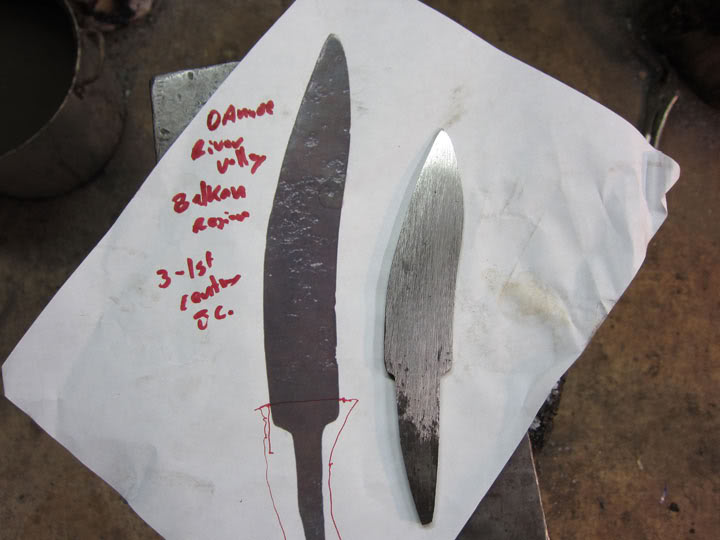
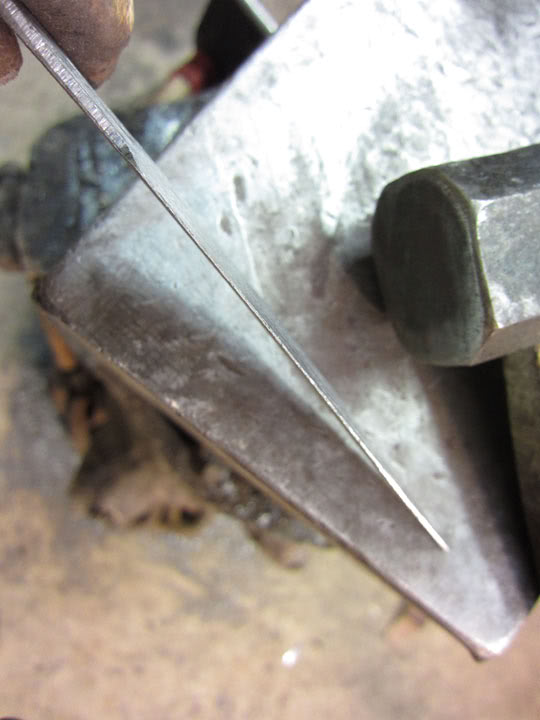
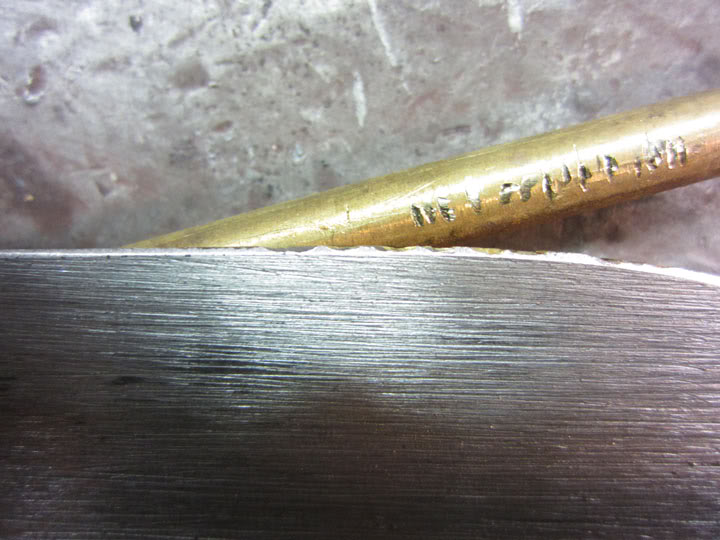
The last picture shows a test I normally do with my steel blades after the quench... the brass rod test. To test my heat treat, I will take a brass rod and hack on it and run the edge along it with pressure and then look for chipping and deformation. I understand that this may be too harsh of a test for any work hardened knife, but I thought it would be a good place to start. Obviously it failed. Since I have no actual experience with work hardened iron blades, I really don't know what to expect. After that, I ground the edge back and then hammered it down even thinner and then went to carving on oak. It held up to that pretty well after about 5 minutes or so and cut very well. So... I will go ahead and put a handle on it and just use it for a while and see how it does. Again.. I would love folk's input on handle designs....
If I start seeing an interesting pattern in terms of usage testing as I work with blades of higher P content, I will send some out for hardness testing. I suppose I should also make a blade and NOT work harden it and see how well that holds up.
I should also add that I'm still playing around with hammer hardening methods. At this point, I really can't do it without leaving small hammer marks. Since you did not see these in actual blades.. either they were able to grind them out due to deep work hardening effects.. or they were just a heck of lot better than be at hammer control. Probably the latter.
Hope this is of interest! I think it will be fun to offer these for sale for people that would like to have very period correct blades in their kits or collections.
http://www.bigrockforge.com
|
|
   |
 |
Scott Roush
Industry Professional

|
 Posted: Sat 23 Apr, 2011 4:06 am Post subject: Posted: Sat 23 Apr, 2011 4:06 am Post subject: |
 |
|
I'm getting my work hardening method down after doing research into how scythes are sharpened. This set-up makes a huge difference in hammer control as I can now work the edge with fine detail and minimal hammer marks.
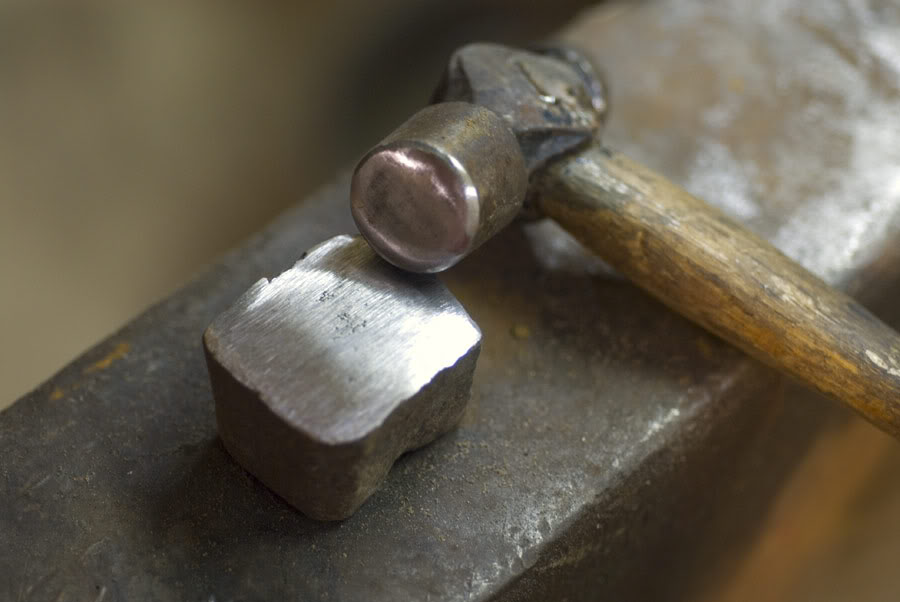
This knife has hardened compared to un-worked iron and is useable as a light duty personal knife. It is very easy to sharpen in the field. But I'm very interested to see how it performs compared to the higher P stuff that I have...
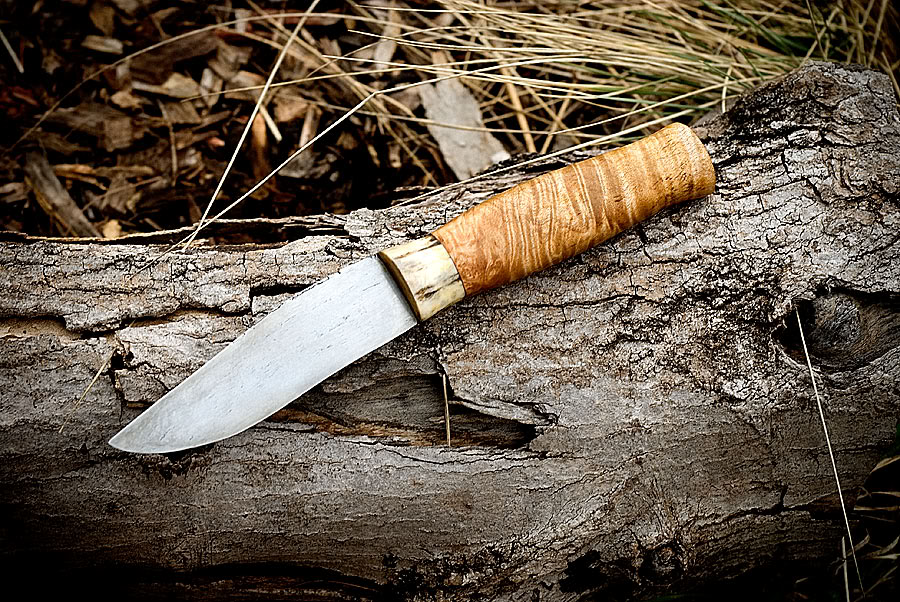
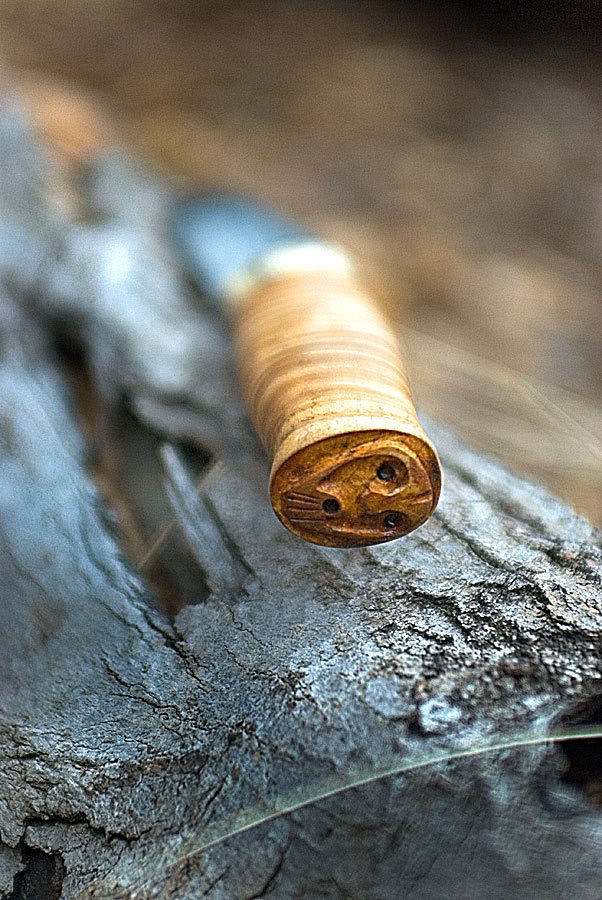
So on to the next one!
http://www.bigrockforge.com
|
|
   |
 |
Michal Plezia
Industry Professional

|
 Posted: Sat 23 Apr, 2011 4:40 am Post subject: Posted: Sat 23 Apr, 2011 4:40 am Post subject: |
 |
|
Very interesting experiment. Thanks for sharing. Have you ever tried this with bronze weapons? I think the technique is quite similar.
www.elchon.com
Polish Guild of Knifemakers
The sword is a weapon for killing, the art of the sword is the art of killing. No matter what fancy words you use or what titles you put to
it that is the only truth.
|
|
   |
 |
Scott Roush
Industry Professional

|
 Posted: Sat 23 Apr, 2011 4:43 am Post subject: Posted: Sat 23 Apr, 2011 4:43 am Post subject: |
 |
|
no I haven't.. but I would like to for a basis of comparison. As mentioned... I really don't know what to expect from even the best work hardened iron.
http://www.bigrockforge.com
|
|
   |
 |
Michal Plezia
Industry Professional

|
 Posted: Sat 23 Apr, 2011 11:20 am Post subject: Posted: Sat 23 Apr, 2011 11:20 am Post subject: |
 |
|
Legendary polish bladesmith, Wojciech Slawinski wrote that he tested a sword made of low carbon steel (0,1%) hardened with hammer and it was able to bend 15 cm and return to true and was able to chop wood and bones without damageing the blade.
Source: http://www.platnerz.com/platnerz-com/scriptor...hniki.html
From my personal experience: my grandafther who was a farmer used to treat the scythe with hammer and claimed it cut better.
www.elchon.com
Polish Guild of Knifemakers
The sword is a weapon for killing, the art of the sword is the art of killing. No matter what fancy words you use or what titles you put to
it that is the only truth.
|
|
   |
 |
|
|
You cannot post new topics in this forum
You cannot reply to topics in this forum
You cannot edit your posts in this forum
You cannot delete your posts in this forum
You cannot vote in polls in this forum
You cannot attach files in this forum
You can download files in this forum
|
All contents © Copyright 2003-2025 myArmoury.com — All rights reserved
Discussion forums powered by phpBB © The phpBB Group
Switch to the Basic Low-bandwidth Version of the forum
|

